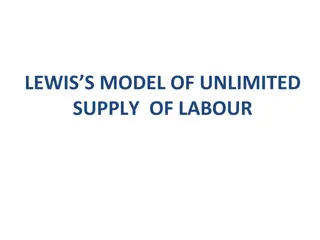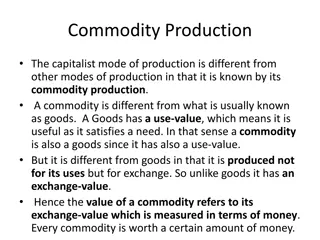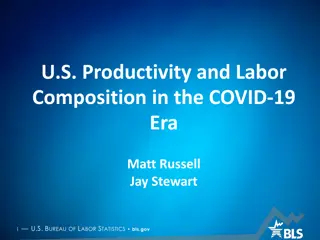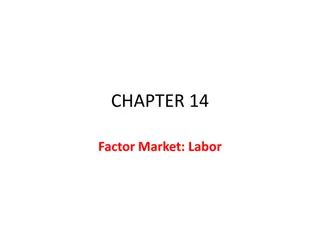Understanding Labor Productivity Growth in Europe: Insights from Productivity Project Conference
Divergent experiences in labor productivity growth between the US and Europe have sparked interest in analyzing factors affecting productivity. The Productivity Project Conference in January 2015 delved into macro and micro-level determinants of labor productivity, focusing on Total Factor Productivity (TFP) analysis concerning labor force composition, collective agreements, and foreign market utilization in the context of European economies like Spain. Various statistical figures and evidence shed light on GDP per capita, labor market performance, and factors influencing it, offering a comprehensive overview of the productivity landscape in Europe.
Uploaded on Sep 25, 2024 | 0 Views
Download Presentation

Please find below an Image/Link to download the presentation.
The content on the website is provided AS IS for your information and personal use only. It may not be sold, licensed, or shared on other websites without obtaining consent from the author. Download presentation by click this link. If you encounter any issues during the download, it is possible that the publisher has removed the file from their server.
E N D
Presentation Transcript
Laura Hospido Eva Moreno Galbis CEPREMAP Productivity Project 23rd January 2015 Conference The opinions and analyses are the responsibility of the authors and, therefore, do not necessarily coincide with those of the Banco de Espa a or the Eurosystem
Motivation The divergent experiences in the US and in Europe have increased the interest in understanding productivity growth. Source: OECD Statistics Figure 1: Labor productivity growth
What we do At the macro level we present facts on the potential determinants of labor productivity. At the micro level: We estimate TFP between 1995-2012 We estimate TFP at the micro level and aggregate then to analyze potential composition effects We focus on the relationship between TFP and several factors: Labor force composition, collective agreements Use of foreign markets
1.GDP per capita From a strict accountability point of view, Y/P=L/P Y/L where Y is GDP, L employment, and P total population. Source: OECD Statistics Figure 2: Labor productivity, GDP per capita and employment over total population in Spain (annual rates of growth, %)
1.1 Labor market performance 75.0 70.0 65.0 GERMANY SPAIN 60.0 FRANCE 55.0 UK 50.0 45.0 1995 1996 1997 1998 1999 2000 2001 2002 2003 2004 2005 2006 2007 2008 2009 2010 2011 2012 Source: OECD Statistics Figure 3: Employment rates in Spain, France, Germany, UK and EU-27 40.0 30.0 35.0 25.0 30.0 20.0 Germany Germany 25.0 Spain Spain 15.0 20.0 France France 15.0 10.0 UK 10.0 UK 5.0 5.0 0.0 0.0 1995 1997 1999 2001 2003 2005 2007 2009 2011 1995 1997 1999 2001 2003 2005 2007 2009 2011 Source: OECD Statistics Source: OECD Statistics Figure 4: Share of temporary workers (panel A) and part-time workers (panel B)
1.1.a. Factors influencing labor market performance Labor Costs: Wages in the private sector only started to exhibit negative growth rates in real terms since 2010 Employment protection: not major divergences in employment protection legislation between Spain and other European countries Hours of work: Stable between 2008-2012
1.1.a. Factors influencing labor market performance Collectiveagreementsystem: Principle of statutory extension: any minimum conditions established in a collective agreement at higher than firm level apply to every worker forming part of corresponding geographical and/or industry unit. the Principle of ultra-activity: any agreement remains valid after its expiry, if it has not been renewed. These two principles make very difficult for a firm to easily adjust to adverse economic conditions=> Reforms 2009, 2010, 2012
1.1.a. Factors influencing labor market performance Demographiccomposition: 1400 50.00 45.00 1200 40.00 1000 35.00 30.00 800 25.00 600 20.00 15.00 400 10.00 200 5.00 0 0.00 2000 2001 2002 2003 2004 2005 2006 2007 2008 2009 2010 1991 1993 1995 1997 1999 2001 2003 2005 2007 2009 2011 France Germany Spain 0 - 29 30 - 49 50 - 64 > 65 United Kingdom United States Source: OECD statistics Source: INE Figure 5: Inflows of foreign population ( in thousand) (panel A) and population composition by age , % (panel B)
1.2 Sector composition 18.00 20.00 17.00 18.00 16.00 16.00 15.00 14.00 14.00 12.00 13.00 10.00 12.00 8.00 11.00 6.00 10.00 4.00 2001 2006 2008 1993 1995 1996 1997 2000 2003 2005 2007 1994 1999 2002 2004 2009 1998 2010 2011 9.00 8.00 Oil, energy, water, mineral non metal products Food, beverdages, tobbaco Textils and shoes Wood and paper Metal products 2008 2009 2010 2011 2012 European Union (27) Spain United Kingdom Germany France Source: INE Source: INE Figure 6: Contribution in % to total employment of the construction sector Figure 7: Contribution in % of each branch to industrial employment
100.0 1.3 Access to credit 80.0 60.0 40.0 20.0 0.0 GER-2007 GER-2010 SP-2007 SP-2010 FR-2007 FR-2010 UK-2007 UK-2010 Owner/administrator Employees Familly, Friends Other firms Banks Other Source: Eurostat Figure 8: Success rate in obtaining loan finance by sources. Total business economy exceptfinancial and insuranceactivities. Percentageof requestsaccepted. 3 2.5 2 1.5 1 0.5 1995 1996 1997 1998 1999 2000 2001 2002 2003 2004 2005 2006 2007 2008 2009 2010 2011 EU (27) Germany Spain France UK Source: INE Figure 9: R&D expenditures in %GDP
1.4 The use of foreign markets Firms have the possibility to circumvent an economic crisis by exporting towards countries less affected by the recession or importing from cheaper suppliers abroad. The balance of payment of the Spanish economy considerably improved during the crisis due to the relative increase in exports. => competitiveness gains seem to be largely explained by the reduction in unitary labor costs, rather than by an improvement in the efficiency of production methods => competitiveness gains have been employment unable to create
2.1 Data sources Our dataset combines information from several data sources: Bank of Spain's Central Balance Sheet and the Mercantile Registries: data on the number of employees by type of contract, business name, location, several balance sheet items, profit and loss account items, standard financial ratios, and sector of activityat the 4-digit level 2) Collective Agreement Registries: data on the level of thecollectiveagreements. 3) Balance of Payment imports/exports 1) Registries: data on
2.1.a Sample selection A) Central Balance Sheet and Mercantile Registries: we have dropped firms with missing or non-positive values for the number of employees, value added, intermediate inputs, physical capital, sectorof activity, and yearof firm creation. B) Collective Agreement Registries: Firms with No Agreement The sample of firms with agreements at the firm level was merged with (A) using the Identifying Fiscal Code of the firm, the name of the firm or the name of theagreement. The sample of firms with agreements at the sectoral level is merged to (A) using an indicator of the sector of activity plus the corresponding geographical location. C) Balance of Payments: add informationon exports and imports. D) We keep 95% of the observations. We have an unbalanced panel of 5,627,593 obs for the period 1995-2012. - - -
2.2 Measuring TFP Estimation of the production function ???= ?0+ ?????+ ?????+ ?????+ ???, ???= ???+ ??? ???= log of gross real output, ???, ???= log of laborand intermediate inputs, ???= log of fixed capital stock, and ???is a random term containing any unobserved factors affecting production: ??? : firm-specific factors (managerial ability, firm specific human capital, efficiency) known by the firm but unobserved to theeconometrician. ???: idiosyncratic term (measurement error or shocks affecting output) unknown when firms make decisions. Assumed to be independentof ???and other inputs which affect productivity
2.2 Measuring TFP Endogeneity The main difficulty for estimation is the endogeneity due to the correlation between ???and observed inputs (Griliches and Mairesse, 1995). OLS generates inconsistent estimates. Fixed effects approach: unobserved firm-specific shocks are assumed to be invariant over time. Any fixed effects transformation allows to recover the parameterestimates. Control function approach Levinsohn and Petrin, 2003): unobserved firm-specific shocks are assumed to follow a Markov process so as they can be obtained by means of a variable which keeps a monotonic relationship with them (e.g. capital investment or intermediate inputs). (Olley and Pakes, 1996;
2.2.a Estimation results OLS L Agriculture 0,704 FE LP K 0,168 L k 0,161 L 0,551 K 0,065 0,368 (0,004) (0,003) (0,004) (0,003) (0,004) (0,007) Extractive 0,804 0,224 0,647 0,187 0,586 0,142 (0,015) (0,009) (0,012) (0,008) (0,018) (0,020) Manufacture 0,871 0,16 0,639 0,134 0,682 0,063 (0,002) 0,751 (0,001) 0,232 (0,001) 0,532 (0,001) 0,158 (0,002) 0,566 (0,002) 0,106 Energy (0,009) 0,784 (0,006) 0,156 (0,009) 0,68 (0,006) 0,093 (0,011) 0,591 (0,014) 0,106 Construction (0,002) 0,85 (0,001) 0,149 (0,001) 0,562 (0,001) 0,114 (0,002) 0,645 (0,001) 0,075 Sales (0,001) (0,001) (0,001) (0,001) (0,002) (0,001) Transport 0,842 0,182 0,588 0,167 0,67 0,094 (0,003) (0,002) (0,002) (0,001) (0,004) (0,003) Tourism 0,857 0,138 0,483 0,106 0,466 0,084 (0,002) (0,001) (0,002) (0,001) (0,003) (0,002) Education- Health 0,765 0,142 0,517 0,095 0,57 0,077 (0,004) (0,002) (0,003) (0,001) (0,004) (0,004) Non financial 0,773 0,16 0,552 0,094 0,614 0,081 (0,001) (0,001) (0,001) (0,001) (0,002) (0,002) Notes: Observations=5,627,593. Bootstrap standard errors in parentheses (100 replications).
2.2.a Estimation results 1995-2007 2008-2012 L K L K Agriculture 0,535 0,102 0,574 0,041 (0,006) (0,011) (0,006) (0,011) Extractive 0,557 0,127 0,614 0,064 (0,023) (0,016) (0,023) (0,039) Manufacture 0,665 0,058 0,707 0,058 (0,003) 0,58 (0,011) (0,002) 0,084 (0,015) (0,003) 0,543 (0,016) (0,003) 0,129 (0,024) Energy Construction 0,556 0,087 0,611 0,059 (0,002) 0,632 (0,002) (0,002) 0,08 (0,001) (0,002) 0,664 (0,002) (0,003) 0,063 (0,003) Sales Transport 0,636 0,097 0,736 0,063 (0,003) (0,004) (0,005) (0,007) Tourism 0,438 0,078 0,49 0,084 (0,004) (0,003) (0,005) (0,005) Education-Health 0,553 0,083 0,595 0,075 (0,005) (0,004) (0,005) (0,006) Non financial 0,597 0,104 0,637 0,063 (0,002) (0,002) (0,002) (0,002) Notes: Observations=3,519,864 for 1995-2007 and 2,098,140 for 2008-2012. Bootstrap standard errors in parentheses (100 replications).
2.2.a Estimation results Lp Lt K Agriculture 0,136 0,113 0,089 (0,002) (0,001) (0,008) Extractive 0,155 0,06 0,172 (0,011) (0,004) (0,021) Manufacture 0,276 0,072 0,094 (0,002) 0,218 (0,000) 0,089 (0,002) 0,132 Energy (0,007) (0,002) (0,013) Construction 0,141 0,106 0,145 (0,001) 0,266 (0,001) (0,001) 0,069 (0,000) (0,002) 0,099 (0,001) Sales Transport 0,225 0,078 0,139 (0,002) (0,001) (0,003) Tourism 0,116 0,047 0,114 (0,001) (0,001) (0,003) Education-Health 0,222 0,086 0,092 (0,002) (0,001) (0,004) Non financial 0,268 0,093 0,095 (0,001) (0,000) (0,001) Notes: Observations=5,627,593. Bootstrap standard errors in parentheses (100 replications).
2.2.b The evolution of TFP ????? exp ??? = exp(??? ?0 ????? ?????) Figure 11: Aggregate TFP growth (employment shares) Figure 10: Firms TFP growth 0.0800 0.0800 0.0600 0.0600 0.0400 0.0400 0.0200 0.0200 0.0000 0.0000 1996 1997 1998 1999 2000 2001 2002 2003 2004 2005 2006 2007 2008 2009 2010 2011 2012 2001 2006 2007 2000 2003 2004 2005 1999 2002 2009 2011 1996 1997 1998 2008 2010 2012 -0.0200 -0.0200 -0.0400 -0.0400 -0.0600 -0.0600 -0.0800 -0.0800 -0.1000 -0.1000 5 year (10 sectors) 5 year (balanced) 5 year (10 sectors) 5 year (balanced) 5 year (Lp & Lt) 5 year (2 subperiods) 5 year (Lp & Lt) 5 year (2 subperiods)
2.3 Margins of adjustment used by the firms ???= ??+ ??+ ?????+ ?????+ ??? ???= adjustment margins, ??and ??= firm and time fixed effects, ???= dummies on the firm's size, age, region of location and indicators of the firm debt structure, ???= random error term.
2.3.a Firm fixed effects regression [1] [2] [3] [4] Share of Lt -0.051*** (0.001) 0.086*** (0.001) -0.037*** (0.002) 0.060*** (0.002) -0.037*** (0.002) 0.063*** (0.002) -0.037*** (0.002) Importer-exporter Importer-exporter-2008 threshold 0.091*** (0.002) 0.076*** (0.020) -0.019*** (0.003) -0.032*** (0.004) -0.003 (0.003) -0.046*** (0.000) -0.005*** (0.000) 3.263*** (0.108) Firm agreement 0.122*** (0.017) -0.025*** (0.002) -0.027*** (0.003) -0.007*** (0.002) 0.075*** (0.020) -0.019*** (0.003) -0.034*** (0.004) -0.004 (0.003) 0.076*** (0.020) -0.019*** (0.003) -0.033*** (0.004) -0.003 (0.003) -0.046*** (0.001) -0.005*** (0.000) 3.258*** (0.109) Province agreement Regional agreement National agreement Debt ratio Short term ratio Constant 3.292*** (0.096) 3.256*** (0.107) Observations R-squared Number of id Robust standard errors in parentheses. Controls: Size and age of the firm. Year, region and sector dummies included. *** p<0.01, ** p<0.05, * p<0.1 5,618,004 0.041 962,232 2,862,843 0.045 735,297 2,862,843 0.051 735,297 2,862,843 0.051 735,297
2.3.b Time variation of the adjustment margins Figure 12: Time variation of the adjustment margins
2.3.b Time variation: Temporary employment rates Figure 13: Temporary employment rates and skill composition
2.3.b Time variation : robustness check Figure 14: Whole sample vs. balanced sample: time variation of adjustment margins
Take away Explanation of the two puzzles: Explanations for the slowdown: proliferation of temporary contracts and prevalence of low productive activities as construction, sales, retail trade, hotels and catering. Explanations for the increase during the Great Recession: massive job destruction (selection of temporary workers). Importer-exporter firms and firms committed to a collective agreementat the firm level display a better behavior. => The "Spanish productivity puzzle" does not respond to permanent factors and results rather from massive job destruction and an increased weight of large firms displaying better TFP performance. Average total factor productivity has been deteriorated during the crisis period.























